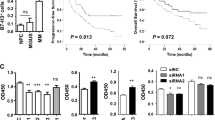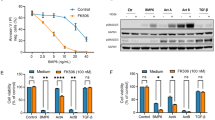Abstract
Human myeloma cells from about 10% of cases with multiple myeloma expressed CD33 and had monocytoid morphology with convoluted nuclei, and all these patients had no increase in serum CRP values. In CD33(+) myeloma cells as well as myeloma cell lines, CD33 expression levels were correlated with the increased expression levels of CEBPA (C/EBPα). This correlation was confirmed by the finding that transfection with the CEBPA gene induced CD33 expression in a CD33(−) myeloma cell line. As suggested by the lack of an increase in serum CRP values in CD33(+) myelomas, IL-6 down-regulated the expression of CD33 in CD33(+) myeloma cell lines along with the down-regulation of CEBPA gene expression. Cucurbitacin I (STAT3 inhibitor), but not U0126 (MAPK inhibitor), could abolish the effect of IL-6. Furthermore, IL-6 up-regulated the expression of MYC via STAT3 phosphorylation and MYC bound to the promoter region of the CEBPA gene followed by the down-regulation of CEBPA expression. It was confirmed that introduction of shRNA for MYC into a CD33(+) myeloma cell line blocked the IL-6-induced down-regulation of CD33 and CEBPA expression. Therefore, these results indicate that IL-6 can reverse the expression level of CD33 by up-regulating MYC followed by the down-regulation of CEBPA expression.





Similar content being viewed by others
References
Adams B, Dorfler P, Aguzzi A, et al. Pax-5 encodes the transcription factor BSAP and is expressed in B lymphocytes, the developing CNS, and adult testis. Genes Dev. 1992;6:1589–607. doi:10.1101/gad.6.9.1589.
Kozmik Z, Wang S, Dorfler P, Adams B, Busslinger M. The promoter of the CD19 gene is a target for the B-cell-specific transcription factor BSAP. Mol Cell Biol. 1992;12:2662–72.
Lin KI, Angelin-Duclos C, Kuo TC, Calame K. Blimp-1-dependent repression of Pax-5 is required for differentiation of B cells to immunoglobulin M-secreting plasma cells. Mol Cell Biol. 2002;22:4771–80. doi:10.1128/MCB.22.13.4771-4780.2002.
Harada H, Kawano MM, Huang N, et al. Phenotypic difference of normal plasma cells from mature myeloma cells. Blood. 1993;81:2658–63.
Huang N, Kawano MM, Harada H, et al. Heterogeneous expression of a novel MPC-1 antigen on myeloma cells: possible involvement of MPC-1 antigen in the adhesion of mature myeloma cells to bone marrow stromal cells. Blood. 1993;82:3721–9.
Van Camp B, Durie BG, Spier C, et al. Plasma cells in multiple myeloma express a natural killer cell-associated antigen: CD56 (NKH-1; Leu-19). Blood. 1990;76:377–82.
Spier CM, Grogan TM, Durie BG, et al. T-cell antigen-positive multiple myeloma. Mod Pathol. 1990;3:302–7.
Ruiz-Arguelles GJ, San Miguel JF. Cell surface markers in multiple myeloma. Mayo Clin Proc. 1994;69:684–90.
Peiper SC, Ashmun RA, Look T. Molecular cloning, expression, and chromosomal localization of a human gene encoding the CD33 myeloid differentiation antigen. Blood. 1988;72:314–21.
Simmons D, Seed B. Isolation of a cDNA encoding CD33, a differentiation antigen of myeloid progenitor cells. J Immunol. 1988;141:2797–800.
Crocker PR. Siglecs: sialic-acid-binding immunoglobulin-like lectins in cell-cell interactions and signaling. Curr Opin Struct Biol. 2002;12:609–15. doi:10.1016/S0959-440X(02)00375-5.
Crocker PR, Varki A. Siglecs, sialic acids and innate immunity. Trends Immunol. 2001;22:337–42. doi:10.1016/S1471-4906(01)01930-5.
Mateo G, Castellanos M, Rasillo A, et al. Genetic abnormalities and patterns of antigenic expression in multiple myeloma. Clin Cancer Res. 2005;11:3661–7. doi:10.1158/1078-0432.CCR-04-1489.
Sahara N, Ohnishi K, Ono T, et al. Clinicopathological and prognostic characteristics of CD33-positive multiple myeloma. Eur J Haematol. 2006;77:14–8. doi:10.1111/j.1600-0609.2006.00661.x.
Kawano MM, Mahmoud MS, Ishikawa H. Cyclin D1 and p16INK4A are preferentially expressed in immature and mature myeloma cells, respectively. Br J Haematol. 1997;99:131–8. doi:10.1046/j.1365-2141.1997.3473161.x.
Shimizu S, Yoshioka R, Hirose Y, Sugai S, Tachibana J, Konda S. Establishment of two interleukin 6 (B cell stimulatory factor 2/interferon beta 2)-dependent human bone marrow-derived myeloma cell lines. J Exp Med. 1989;169:339–44. doi:10.1084/jem.169.1.339.
Nagai T, Ogura M, Morishita Y, et al. Establishment and characterization of a new human Bence Jones-type myeloma cell line, NOP-2. Int J Hematol. 1991;54:141–9.
Shimizu S, Takiguchi T, Fukutoku M, et al. Establishment of a CD4-positive plasmacytoma cell line (AMO1). Leukemia. 1993;7:274–80.
Bodger MP, Hart DN. Molecular cloning and functional analysis of the CD33 promoter. Br J Haematol. 1998;102:986–95. doi:10.1046/j.1365-2141.1998.00863.x.
Liu S, Otsuyama K, Ma Z, et al. Induction of multilineage markers in humna myeloma cells and their down-regulation by interleukin 6. Int J Hematol. 2007;85:49–58. doi:10.1532/IJH97.06132.
Liu S, Ishikawa H, Li F, et al. Dehydroepiandrosterone can inhibit the proliferation of myeloma cells and the interleukin-6 production of bone marrow mononuclear cells from patients with myeloma. Cancer Res. 2005;65:2269–76. doi:10.1158/0008-5472.CAN-04-3079.
Kawano M, Hirano T, Matsuda T, et al. Autocrine generation and requirement of BSF–2/IL-6 for human multiple myelomas. Nature. 1988;332:83–5. doi:10.1038/332083a0.
Klein B, Zhang XG, Jourdan M, et al. Paracrine rather than autocrine regulation of myeloma-cell growth and differentiation by interleukin-6. Blood. 1989;73:517–26.
Hirano T, Nakajima K, Hibi M. Signaling mechanisms through gp130: a model of the cytokine system. Cytokine Growth Factor Rev. 1997;8:241–52. doi:10.1016/S1359-6101(98)80005-1.
Antonson P, Pray MG, Jacobsson A, Xanthopoulos KG. Myc inhibits CCAAT/enhancer-binding protein alpha-gene expression in HIB–1B hibernoma cells through interactions with the core promoter region. Eur J Biochem. 1995;232:397–403. doi:10.1111/j.1432-1033.1995.397zz.x.
Zada AA, Pulikkan JA, Bararia D, et al. Proteomic discovery of Max as a novel interacting partner of C/EBPalpha: a Myc/Max/Mad link. Leukemia. 2006;20:2137–46. doi:10.1038/sj.leu.2404438.
Legraverend C, Antonson P, Flodby P, Xanthopoulos KG. High level activity of the mouse CCAAT/enhancer binding protein (C/EBP alpha) gene promoter involves autoregulation and several ubiquitous transcription factors. Nucleic Acids Res. 1993;21:1735–42. doi:10.1093/nar/21.8.1735.
Cartwright P, McLean C, Sheppard A, Rivett D, Jones K, Dalton S. LIF/STAT3 controls ES cell self-renewal and pluripotency by a Myc-dependent mechanism. Development. 2005;132:885–96. doi:10.1242/dev.01670.
Acknowledgments
This work was supported in part by grants from the Japanese Ministry of Education, Science, Sports and Culture of Japan, and the Ministry of Health, Labour and Welfare of Japan.
Author information
Authors and Affiliations
Corresponding author
About this article
Cite this article
Shamsasenjan, K., Otsuyama, Ki., Abroun, S. et al. IL-6-induced activation of MYC is responsible for the down-regulation of CD33 expression in CD33(+) myeloma cells. Int J Hematol 89, 310–318 (2009). https://doi.org/10.1007/s12185-009-0256-y
Received:
Revised:
Accepted:
Published:
Issue Date:
DOI: https://doi.org/10.1007/s12185-009-0256-y




